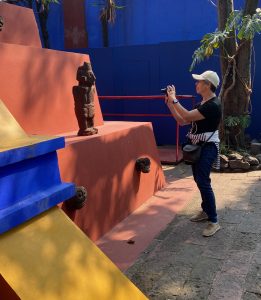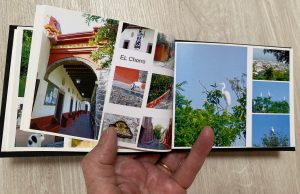During the great Age of Exploration, from the 15th century to the early 17th, there was usually a man on board each sailing ship, if not the captain himself, who took careful notes. How else would we have learned of their voyages and exploits on their return?
Love him or hate him, Christopher Columbus was particularly good at this. “Columbus’s 1492 Journal,” I read online from the King’s College Library, “even in the truncated and partially summarised form in which it has survived, gives an unrivalled insight into the events of the voyage, Columbus’s first impressions of a people and a culture which failed in so many ways to live up to his expectations, and the creation of many of the myths surrounding the New World which have coloured its view of itself down to the present day” (https://ems.kcl.ac.uk/print/b001.html ).

Fast-forward now to our own age and explorations:
Travel, like food, I feel, invites sharing — Come, partake of my experience! See what I saw, taste what I tasted, meet those I met! – if only in less-than-perfect written words or quickly snapped photos. We strive to capture the moments, preserve them, as our own memory-joggers and as conversation-starters with friends and family.
“It’s a wonderful thing to do, no question, for both practical and sentimental reasons,” agrees blogger and podcaster Debbie Weil, in her newest post, “How [Not] to Keep a Travel Journal” (https://debbieweil.substack.com/p/how-not-to-keep-a-travel-journal).
“It’s your souvenir scrapbook and a future travel guide,” Debbie says. “It’s a place to record impressions for a future writing project. Here’s where you build a trove of new sensations of sight, sound and smell. Surely you will draw on them later; otherwise you’ll forget!” She then suggests in her post practical ways to overcome the pitfalls.
When my friend from Paris, Marie-Laure, was here for a visit recently, I was reminded of her method of documenting her travels. She’s an avid amateur photographer and always has been. As a former teacher, she traveled widely every summer holiday from teaching. She’s been all over the world – and has the photos and notes to prove it. She stops to photograph almost everything and documents it all in writing every evening — where she went and what she saw that day.

This was not Marie-Laure’s first visit to San Miguel, however. The first was in the summer of 2016, and I wrote about that visit and our long friendship and many travels in a blogpost at that time (www.blog.bonnieleeblack.com/mi-amiga-de-francia/).
While here this time she tried to jog my memory: “Remember when we went to… and saw…?” I’d forgotten, frankly. That was seven years ago; I can barely remember what I saw and did yesterday. Then she surprised me with a little book she’d put together for me of photos of that previous visit. Turning its pages in my hand brought back all of the memories I was afraid I’d forgotten.

Marie-Laure, now seventy-five, has lived in Paris all her life. I, on the other hand, have lived here and there, in various countries of the world, for various stretches of time before settling in normally sunny (but not this week!) San Miguel de Allende, Mexico. Happily, Marie-Laure, my lifelong adventurous French friend, has made a point of visiting me wherever I’ve lived.
She visited me when I lived in Ségou, Mali, and of course took many lovely photos while there – a number of which appear in her just-published French edition of my Mali book, How to Make an African Quilt: The Story of the Patchwork Project of Ségou, Mali.
This was her second surprise for me on this recent visit: In the ten years since my Mali book was published, she had, with my blessing, translated and adapted it, and it has just been published in paper and e-book form by a publisher in Finland as Patchwork Africain: Histoire du Projet Patchwork à Ségou au Mali. (For more about this, please go to: https://www.atramenta.net/ebooks/patchwork-africain/1274/.)
It has always been my hope and prayer that a reader of this Mali book would be inspired to help the Patchwork Project stay alive after my departure from Mali. Since Mali is a Francophone country, which has long historical ties with France, perhaps a French reader will be more likely to do so than any English-reading reader has been. Vamos a ver! (we’ll see), as we say here in Mexico.
As for my own favorite method of documenting my foreign travels and sojourns, I’ve always favored my beloved written word. In the decades before e-mail, I wrote long, detailed letters home from overseas – first to my mom, then to other family members and friends. All of these loved-ones saved my letters and gave them back to me, and these letters became invaluable resources when I wrote my three Africa memoirs.
I’m sure I don’t need to tell you — whether you’re a writer or a photographer, a note-taker or a voice-recorder, whatever medium you call your own – keeping a lasting record of your travels will extend your experiences indefinitely. Travel itself enlarges our minds and hearts – teaches us about the worth and accomplishments of distant peoples (in ways we should have but didn’t learn in school). Documenting those travels, a little like the early explorers did in their day, keeps those experiences alive.

Bonnie, how fun to see your reference to my recent essay about travel journaling. Love your posts as always. Sam and I also saw Frida Kahlo’s house recently in MX City! Such a tragic life (at least that was my takeaway).
Wonderful, Debbie! I was just about to send it to you. You beat me to it. — xx
As always so enjoyable to read. I, too, am thankful for all the documentation I have made from my travels and should do more to get them a readable order. Words or photos—both work to replenish the memories.
Thank you, dear Barbara! I’m so glad you enjoyed this post. — xx
Great post Bonnie. When I first started writing my travel blog, it was a way of keeping in touch with friends and family while I was roaming the world without an itinerary. It quickly became a way of paying more attention — describing what struck me as important or quirky or delightful about the places I visited. I never planned to re-read it, but when I do, the posts return me to the temple incense, the sound of the call to prayer, the momentary revelations I experienced in art museums, and the feelings of connection and joy I felt with so many strangers.
Thanks so much, querida Kim! Yes, your travel blog is a treasure. I don’t have the link for it at my fingertips right now, but I’ll look for it and post it here asap. — xx
Here’s the link to Kim’s blog, as promised: http://www.kimmie53.com .
Hola, la Bonnie! There is nothing like the written word to preserve memories. But I love the albums, with physical, touchable paper photos, that Marie-Laure put together. Even if everything digital were to vanish somehow, you will still have a physical reminder of the trips. Congratulations for the French edition of ow to Make an African Quilt. Cheers!
Yes, dearest Te, we LOVE the written word — on paper! And I too am super-excited that there’s now a French edition of my Mali book — all thanks to Marie-Laure. I’ve given her the rights, so she will get the benefit.
Dearest Bonnie,
I relate to everything you’ve written here. Travel DOES invite sharing. I had friends in their youth that wanted to go through all their hundreds of photos from their travels, and I quickly learnt to tell them in advance, upon their return, choose ten special memories and share them with me over coffee. I was more curious about their choice and why, than in spending hours looking at snapshots.
The written word is so much more valuable. All the letters I wrote to my mother and brother and friends were given back to me many years later. I barely recognised the young woman I was, her thoughts and observations of the simplest of things within a different culture. It wasn’t just a memory of the travel. It was a glimpse into the person I was- one I had forgotten, but oddly, was instrumental in developing into who I am today.
I love the internet and digital photos and all the doors its opened, and the tools it can provide us with, one of these being the photo book. What a treasure your friend gave you!
I also hope someone does pick up the Patchwork Project as well.
Hugs.
Dearest Loula — I love it when you share your own experiences like this. It’s so enriching for me — and all of us. Yes, I hope-hope-hope ONE person reads the French version and is moved to jump in on the Patchwork Project in Mali. Keeping fingers crossed. 🙂
Oh, dear Bonnie, how thrilled I was to read this recent post with its theme of travel. It couldn’t be more á propos at this time for me: I just published the 50th Anniversary Edition of my very first book, Europe with Two Kids and a Van, Travel Memoir and Guide. Like you I cherish the memories of my travels then with my two young daughters ages 3 and 5 and all my many travel adventures in various parts of the world since as well. Also, like for you, one of the greatest joys of those travels has been the friends I’ve made along the way. I also have a dear French girlfriend whom I met the second day I was in France working right out of college. We are the same age and though from different cultures, we have shared so much in common over the years. I can understand how happy you were with Marie-Laure’s visit to San Miguel. I well remember when Michelle visited me in San Miguel. How wonderful that your “amie” has written a French edition of your Mali Book! I hope to read it! As usual, your post has brightened my day and filled me with memories of my own many travel adventures.
I’m thrilled to read this, dear Sher! And I’m so glad you mentioned the 50th anniversary edition of your first book! I hope you are able to get and read Marie-Laure’s French edition of my Mali book. My French isn’t quite good enough to read every word of it — but I know the story. 🙂 I love all of her photos in it, too. — Best wishes, Bonnie
Dear Bon,
What a wonderful gift your friend Marie-Laure has given you: Making your words available to a new host of readers by translating and expanding your text with her own pictures! It is a truly beautiful thing to do.
It’s been a long time time since I read a book in French. I think I could read it slowly, with Google Translate in front of me. It would fun to try, and it would possibly lead me to be more fluent. I would certainly enjoy that.
Love,
Paul
Dearest Paul — So good to receive this from you! Yes, please try to read the Mali book in French. (I should do the same!) If you have trouble getting it, try going to Amazon and typing in the French edition’s title, PATCHWORK AFRICAIN. That should work! — BB xx
mi querida amiga
What an insightful and helpful blog .
While I don’t take copious notes, I record my memories primarily in photographs, reading your blog today jogged me into a promise to myself to put more down in words. Having just returned late last night from a short memorable visit to Florida and South Carolina, I shall do that.
Felicidades on the French edition of your delightful book that I so enjoyed reading.hope to see you very soon Aloha JJ
Thank you, querida Judith! Yes, we’ll get together SOON. 🙂
And let’s remember that SKETCHES of our travels are equally as valuable as photos!
Yes, dear Judy, that’s true too! I forgot to include sketching! — 🙂